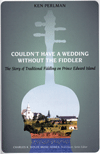
KEN PERLMAN - Couldn’t Have A Wedding Without The Fiddler: The Story Of Traditional Fiddling On Prince Edward Island
University Of Tennessee Press ISBN: 9781621900979
I’m trying hard to keep this review to a reasonable length because it would be easy to write extensively about its many facets. Despite its relatively modest size this is a major piece of work which deserves wide attention.
There is a well-known saying – ‘you can’t judge a book by its cover’ - meaning one should not form an opinion on someone or something based purely on what is seen on the surface, because after taking a deeper look, the person or thing may be very different than what was expected. I think this holds true for this book. The title is a reference to the importance of musicians in a relatively remote rural community. To quote from the book “…the three most important people in the town. The minister was first, the schoolteacher was next, and the fiddler was next. Couldn’t have a wedding without the fiddler!” The subtitle The Story Of Traditional Fiddling On Prince Edward Island, is more indicative of the content and, if that is what you are interested in, then this book is a must read. But there is another story in the pages of this book - a fascinating story of traditions and revival. This story of a revival of fiddling could easily parallel the more song based revival in Britain and Ireland.
To give you some background again I’ll quote directly from the introduction to the book. “Prince Edward Island in Eastern Canada is home to one of the oldest, strongest and most vibrant fiddling traditions in North America. Fiddling was first established there by Scottish immigrants in the late 18th century, was influenced by Irish immigrants a generation or two later, and was seasoned by the unique sensibilities of the original European inhabitants of the Island: the Acadian French. When 20th century technology and social organisation did become firmly established on Prince Edward Island in the 1950s and 60s they almost put an end to Island fiddling. As the lure of new forms of entertainment such as television films became irresistible, Islanders ceased gathering with their neighbours. A new generation coming of age found its own music and fiddling was increasingly looked at as something that appealed only to old people. This decline was stemmed to some degree by a revival - that is an organised rekindling of interest - that got underway in the 70s and fiddling slowly made its way back to prominence adapting in the process to a new set of social conditions.”
The author, Ken Perlman, was both an observer and a participant in that revival and this book has been a 25 year or longer project for him.
I rate this book highly. It is good for a general reader but beyond that I think that it should be required reading for anyone involved in what might be termed ‘folk development’. There was a lot in the book that caused me to think and reassess some of my own opinions. Again, for brevity, I will pick out just one example. The book informs us that the revival in Prince Edward Island was launched and carried out primarily by cultural insiders - Islanders who had grown up during the traditional period when house parties and community dances flourished. From these formative experiences, they absorbed certain attitudes and developed certain approaches to problem-solving that strongly affected the course of this revival. At a time when many of our traditions are increasingly in the stewardship of people who might be better defined as ‘arts professionals’ than cultural insiders, this book may serve as a stimulus for them to be more inclusive.
This book has set an incredibly high standard and is a credit to Ken Perlman.
www.kenperlman.com
Pete Heywood
| Buy
this CD online from The Listening Post The Listening Post is the CD mailorder service of The Living Tradition magazine. This album was reviewed in Issue 115 of The Living Tradition magazine. |

